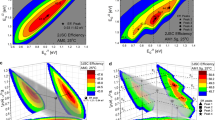Abstract
Technical issues for the performance characterization of silicon-based thin-film multi-junction devices, such as the a-Si/thin-film c-Si structure, are discussed. The measured spectral response of each component cell is affected by the shape of the I-V curves of the component cells under color bias light, as well as the applied bias voltage. This paper describes procedures for correcting the measured spectral response. High-fidelity solar simulators, which incorporate Xe lamp(s) and halogen lamps that simulate AM1.5G standard sunlight, are very useful for characterizing the I-V curves of the multi-junction devices. They can accurately reproduce the current generated in each component cell and the I-V curve of the devices under standard sunlight, with a simple spectral adjustment procedure, thanks to their basic good spectral fidelity to standard sunlight. The irradiance dependence of the I-V curve is important for translating the I-V curve under different irradiance conditions. Although translation is not straightforward for multi-junction devices, the experimental results of the present study suggest that it is possible under spectral conditions where the relative value of the photocurrent among the component cells is constant. Determination of the I-V curve of each component cell based on the I-V curves of the multi-junction devices is also mentioned.
Similar content being viewed by others
References
S. Igari, Y. Imura, S. Shimada and N. Watanabe, “Conceptual design on solar simulator for large area multi-junction PV devices”, Tech. Digest of PVSEC-11, Sapporo (1999) 707
R. Shimokawa, F. Nagamine, M. Nakata et al., “Supplementary-light method for measuring the conversion efficiency of multijunction solar cells”, Jpn. J. Appl. Phys. 28 (1989) L845–L848
K. Emery, M. Meusel, R. Beckart et al., “Procedures for evaluating multijunction concentrators”, Proc. 28th IEEE PVSC, Anchorage (2000) 1126
M. Meusel, R. Adelhelm, F. Dimroth et al. “Spectral mismatch correction and spectrometric characterization of monolithic III-V multi-junction solar cells”, Prog. Photovol: Res. Appl. 10 (2002) 243
M. Meusel, C. Baur, G. Letay et al. “Spectral response measurements of monolithic GaInP/Ga(In)As/Ge triple-junction solar cells: measurement artifacts and their explanation”, Prog. Photovol: Res. Appl. 11 (2003) 499–514
Y. Hishikawa and S. Igari, “Characterization of the I-V curves of multi-junction solar cells/modules by high-fidelity solar simulators and their irradiance dependence”, to be published in the Proceedings of the 19th European Photovoltaic Solar Energy Conference (2004) Paris.
J. Burdick and T. Glatfelter, “Spectral response and I-V measurements of tandem amorphous-silicon alloy solar cells”, Solar Cells, 18 (1986) 301–314
N. G. Tarr and D. L. Purfrey, “An investigation of dark current and photocurrent superposition in photovoltaic devices”, Solid State Electronics 22 (1979) 265–270
Y. Hishikawa and S. Okamoto: “Dependence of the I-V characteristics of a-Si solar cells on illumination intensity and temperature”, Sol. Energy Mater. Sol. Cells 33-2 (1994) 157–168
Y. Hishikawa, Y. Imura and T. Oshiro: “Irradiance-dependence and translation of the I-V characteristics of crystalline silicon solar cells”, Proc.28th IEEE Photovoltaic Specialists Conference (2000) Anchorage, 1464–1467
A. Nakajima, M. Ichikawa, T. Sawada et al.: “Improvement on actual output power of thin film silicon hybrid module”, Proc. WCPEC3, Osaka (2003)
R. Adelheim and K. Beucher: “Performance and parameter analysis of tandem solar cells using measurements at multiple spectral conditions”, Sol. Energy Mater. Sol. Cells 50 (1998) 185–195
Y. Tsuno, Y. Hishikawa and K. Kurokawa, “Separation of the I-V curve of each component cell of multi-junction solar cells”, to be published in the proceedings of the 31st IEEE Photovoltaic Specialists Conference (2005) Lake Buena Vista
Acknowledgments
This work was supported by NEDO under the Ministry of Economy, Trade and Industry.
Author information
Authors and Affiliations
Rights and permissions
About this article
Cite this article
Hishikawa, Y. Characterization of the Silicon-Based Thin Film Multi-Junction Solar Cells. MRS Online Proceedings Library 862, 231 (2004). https://doi.org/10.1557/PROC-862-A23.1
Published:
DOI: https://doi.org/10.1557/PROC-862-A23.1




